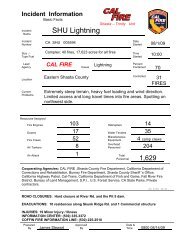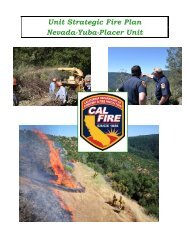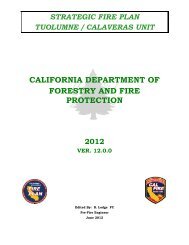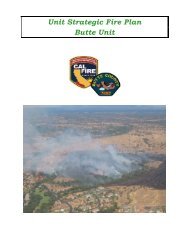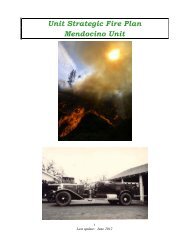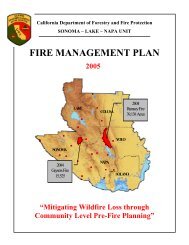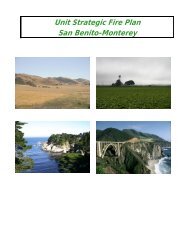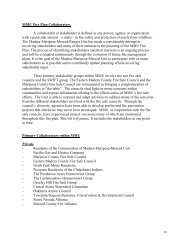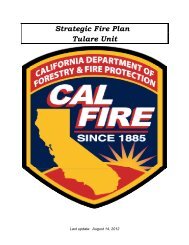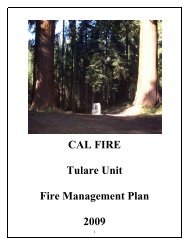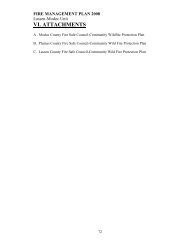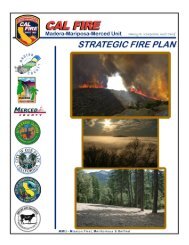Nevada-Yuba-Placer Strategic Fire Plan 2011 - Board of Forestry ...
Nevada-Yuba-Placer Strategic Fire Plan 2011 - Board of Forestry ...
Nevada-Yuba-Placer Strategic Fire Plan 2011 - Board of Forestry ...
Create successful ePaper yourself
Turn your PDF publications into a flip-book with our unique Google optimized e-Paper software.
Appendix K – Project Description<br />
NEVADA – YUBA - PLACER FUELS REDUCTION PROJECT PROPOSAL<br />
Ongoing Priority # 1 Project<br />
PROJECT DESCRIPTION: All <strong>of</strong> the field projects identified in the <strong>Nevada</strong>-<strong>Yuba</strong>-<strong>Placer</strong> Pre-fire<br />
Management <strong>Plan</strong> identify the need for a chipper. In the NYP CDF Unit, the chipper will provide<br />
support to the homeowners that do the clearing around their structures as required by the Public<br />
Resources Code ( PRC 4291) and be utilized to reduce the material removed from the shaded<br />
fuel breaks to a manageable size.<br />
Once the homeowners accomplish their necessary 4291 clearance, they need a way to dispose<br />
<strong>of</strong> the vegetative waste that is created. The current options are: burn it, haul it to a disposal site,<br />
pile it and allow it to turn to mulch, or hire a contractor to dispose <strong>of</strong> it. Additionally, studies have<br />
shown that defensible space and construction materials have the greatest effect on a structure’s<br />
survival <strong>of</strong> a wildland fire. This project directly affects defensible space and will have the most<br />
effect in reducing structure damage or loss in wildfires.<br />
The <strong>Fire</strong> <strong>Plan</strong> assessment process has identified debris escapes as the leading cause <strong>of</strong><br />
ignitions throughout the Unit. This debris burning results in an increased fire risk and diminishes<br />
the air quality, both <strong>of</strong> which are potentially hazardous to the public. As the rural population<br />
continues to grow throughout the Unit, both air quality and fire risk are going to become bigger<br />
issues. The Northern Sierra Air Quality Management District (AQMD), <strong>Placer</strong> County Air<br />
Pollution Control District, and the Feather River AQMD all strongly support the use <strong>of</strong> a chipper<br />
program to accomplish the required fuels reduction.<br />
Another problem inherent to an increasing population is that <strong>of</strong> waste disposal. Currently our<br />
landfills are becoming overburdened with waste. The addition <strong>of</strong> vegetative waste only<br />
compounds the problem. One advantage <strong>of</strong> the chipper program is that it reduces the volume<br />
<strong>of</strong> the vegetative material and also expedites the process <strong>of</strong> natural breakdown. The <strong>Nevada</strong>-<br />
<strong>Yuba</strong>-<strong>Placer</strong> Pre-fire Management <strong>Plan</strong> designates that the chips created in this process will be<br />
distributed back onto the property <strong>of</strong> origin allowing the landowners to utilize the material as<br />
they see fit. Dispersion <strong>of</strong> the chipped material back onto the site also reduces the germination<br />
<strong>of</strong> annual grasses and the sprouting <strong>of</strong> brush.<br />
Many landowners have constructed piles from the material they removed. However, due to the<br />
restriction <strong>of</strong> burn days and the cost and labor requirements to haul it away they just allow the<br />
piles to sit and decompose naturally. This system is beneficial in that it does not reduce air<br />
quality; however, it does create many heavy pockets <strong>of</strong> dead fuel available to an encroaching<br />
fire. These pockets <strong>of</strong> fuel can have an adverse effect on fire behavior. A slow moving ground<br />
fire burning into one <strong>of</strong> these piles will increase the potential for spotting and hamper control<br />
efforts. Depending on the placement <strong>of</strong> the piles, there is an increased chance for torching<br />
nearby trees and other vegetation.<br />
141



